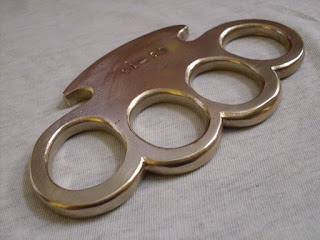This design and finger hole shape are perfect for most hands depending on size of knuckle duster, they are very comfortable and safe too use, the large palm rest and finger hole shape make these comfortable and sit in the palm of the hand securely and safely.
These took approx 6 - 8 hrs to make and was one of the hardest type of brass the maker has ever used, drilling was very hard with two drill bits breaking, luckily when the fileing the finger holes the maker used a rasp type bit in a drill to shape the fingers holes very quickly
The size is suited to Medium or Large hands.
Features oval finger holes and a curved palm rest, weight is quite heavy due it being brass, brass can feel heavy when carried or worn and some people find them too heavy, and certainly is considerably heavier when weighed against aluminium of the same thickness.
Features the makers mark wc-15 and 2015
Overall I would say Brass makes a very attractive knuckle duster and due to its design is also practical too, at a later date I will re-sand these to a mirror finish, thats should happen sometime later in july 2015
Dimensions - 120mm wide, 67mm high, 6mm thick, Finger holes are 25mm wide.
Please leave a comment letting me know what you think! Thanks.
Tags : Бокс (оръжие), Puny americà, Boxer (zbraň), Dyrnau haearn, Knojern, Schlagring, Puño de acero, Puño Americano, Altzairuzko ukabila, Nyrkkirauta, Tirapugni, ナックルダスター, Kastete, Kastet, Buku lima, Boksbeugel, Knokejern, Soco-inglês, Кастет, Boksar (orožje), Knogjärn, Muşta, 鐵蓮花, Knuckle dusters, knuckles,solid brass,for sale, sell, gta v, grand theft auto, 5, five, GTAV, GTA V, home made, handmade, for sale, sell, gold, buy, trade, u.k, england, how to make, howto, tutorial, Brass Knuckles, Brass Knucks, Poing Americain, for sale, sell, trade, selling, swap, solid.
BRASS KNUCKLES FOR SALE BELOW FROM AMAZON - IGNORE PIC IN FIRST LINK - ITS THE OTHER ITEMS THEY ARE SELLING WITH THE BRASS KNUCKLES












